C Curl vs D Curl: Which Eyelash Extension is Best for You?
Eyelash extensions offer a method to transform your gaze by adding volume, length, and curl.
When exploring your options, you'll inevitably encounter C curl vs D curl – two of the most popular and versatile choices.
While C curl delivers a gentle, natural lift that mimics the effect of a traditional eyelash curler, D curl offers a more dramatic, open-eye effect.
Understanding these distinct differences is key to achieving your ideal look.
This article will break down everything you need to know, from their unique features and suitability for various eye shapes to essential maintenance tips and the importance of expert consultation, ensuring you make the best choice for your eyes.
As an experienced lash technician with over five years in the aesthetics industry, I've worked closely with a wide variety of clients to help them achieve their ideal lash look.
This guide will help you understand the subtle yet meaningful differences between C Curl and D Curl, so read on to find your perfect match.
What Are C Curl Eyelash Extensions?
C Curl extensions offer a natural-looking lift that closely mimics the curvature of a traditional eyelash curler.
According to CharmLash, one of the most reputable websites for eyelash extensions, C Curl is the most popular type of lash and creates a natural look.
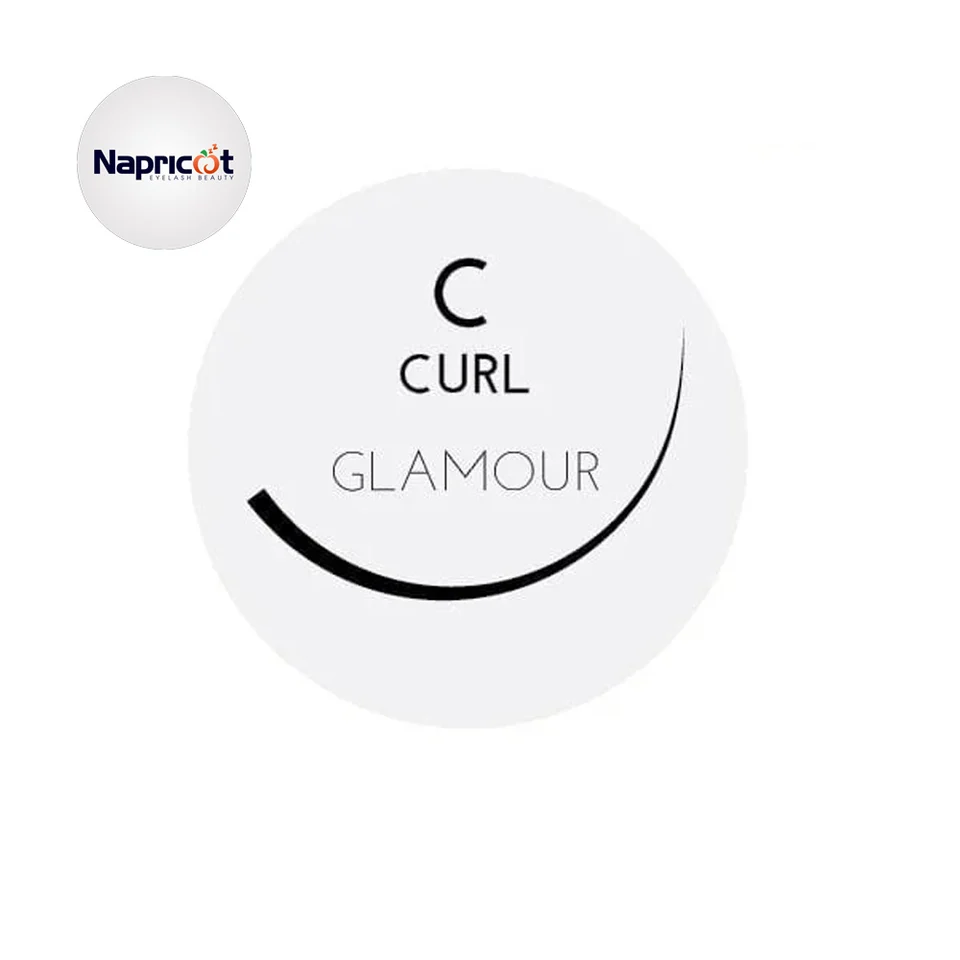
They are a popular choice for clients who want an enhanced look that remains subtle.
These lashes are ideal for everyday use, especially for clients with naturally straight to slightly curled lashes.
- Curl: C Curl has a 60 degree curl
- Conformation: Base short then quickly turns into a gentle curve from root to tip
- Curve Comparison: Less curl than CC Curl and D Curl but curlier than B Curl and J Curl
Mrs. Helen has naturally straight lashes and round eyes. She wanted a natural effect that was suitable for her daily work.
The technician advised using C Curl with moderate length, the result is that the eyes are gently opened, the lashes are in harmony with the face and not too prominent.
After 4 weeks, the lashes still retain their natural curl, the customer is satisfied because they feel light and easy to care for.
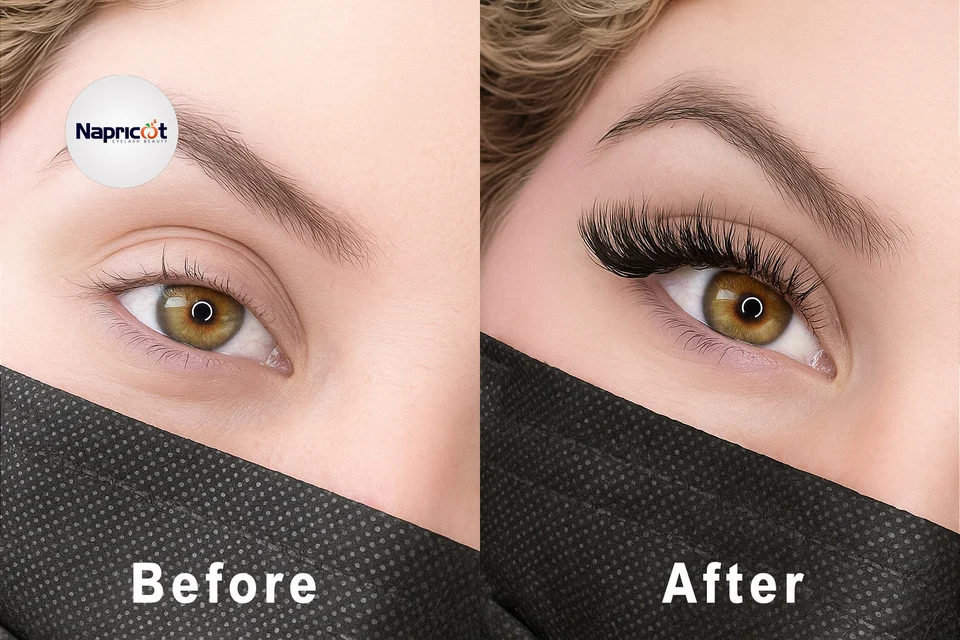
Pros vs cons:
Pros:
- Natural-looking curve: C curls mimic the lift of a traditional eyelash curler, offering a “my-lashes-but-better” effect suitable for daily wear and professional settings.
- Eye-opening effect: The curve (approximately 60°) gently opens the eyes, making them appear larger and brighter without being overly dramatic.
- C Curl optimal candidates: Single eyelids (monolids), slightly hooded eyes, clients with naturally long lashes, and enhances straight or slightly downward-facing natural lashes.
- Easy application: The medium curve makes C curl beginner-friendly and easier for lash artists to isolate and attach compared to more dramatic curls.
- Good Adhesion and Low Maintenance: The curve hugs natural lashes, resulting in solid adhesion and retention of 2–3 weeks. Less need for daily curlers—just brush gently and avoid oil-based products.
- Versatile styling: Can be used in classic, hybrid, or volume lash sets and easily combined with other curls (like D curl) for effects such as cat-eye or squirrel-eye.
Cons:
- Limited lift for certain lash types: Not ideal for very downward-pointing natural lashes or for strongly hooded/deep-set eyes; a stronger curl (like D or L) may be necessary.
- Subtle impact for dramatic looks: May be too soft or “understated” for clients seeking a bold, high-impact look on stage or in photoshoots.
- Not optimal for sparse or weak lashes: Might not add enough density or coverage alone; often requires use of more fans or mixed curls for better results.
- Can be less visible on strongly downward lashes: The moderate curve can sometimes “hide” behind the lash line if natural lashes are angled sharply downward.
- Effect Fades Visually Faster: While the lashes themselves may have good retention, the lifting effect of the gentle C curl can diminish more quickly as natural lashes grow. This can create the need for refills sooner to maintain the initial open-eye look compared to more dramatic curls.
Characteristics of C Curl Eyelash Extensions
Physical Properties:
C curl eyelash extensions are distinguished by their specific curvature of approximately 60 degrees, creating a gentle "C" shape that provides moderate lift and curl. The extensions feature a short base that flows quickly into a slight curl from root to tip, resulting in a natural-looking enhancement that opens up the eye area effectively.
Visual Impact and Aesthetic Properties:
- Balanced Enhancement: C curl extensions create a natural and harmonious lifted appearance that complements rather than overwhelms natural lashes. They provide a moderate opening effect that enhances eye definition and wakefulness without appearing artificial.
- Color and Finish: These extensions typically feature a deep black color that many clients prefer for classic eyelash techniques. Its rich pigmentation helps create definition and depth while maintaining a natural appearance.
- Curl Retention: C curl extensions maintain their shape well over time, providing consistent lift throughout the wear period. The gentle curvature allows for good retention while avoiding excessive tension on natural lashes.
Application Characteristics:
- Beginner-Friendly: C curl extensions are considered easier to apply compared to more dramatic curls like D or L curls, making them an excellent choice for newer lash artists developing their skills.
- Versatile Technique Compatibility: These extensions work well with various application techniques, including classic, hybrid, and volume lash sets. They can be used individually or combined with other curl types for customized looks.
- Blending Capabilities: C curl extensions blend seamlessly with natural lashes, creating smooth transitions and natural-looking results. This makes them particularly effective for clients seeking subtle enhancement.
Suitable Eye Shapes for C Curl Extensions
Ideal Eye Shapes
- Almond-Shaped Eyes: C curl extensions are exceptionally well-suited for almond eyes. This eye shape is naturally versatile and accommodates the moderate curl beautifully. The gentle curve complements the natural symmetry of almond eyes while enhancing their inherent elegance.
- Round Eyes: For clients with round eyes, C curl extensions help elongate and soften the eye shape, creating the illusion of more almond-shaped eyes while avoiding the "surprised" look that stronger curls might produce. The moderate lift helps balance the circular shape naturally.
- Slightly Curved or Straight Natural Lashes: C curls work particularly well for clients with naturally straight or slightly curved lashes, providing the perfect amount of lift to enhance their natural lash line without overwhelming it.
- Monolid Eyes: Depending on the degree of the monolid, C curls can be suitable for some monolid eye shapes. They provide a gentle lift that opens up the eyes and creates a natural, flattering look, though individual assessment is recommended.
Eye Shapes to Consider Carefully
- Hooded Eyes: While C curls can work for some hooded eyes, they may not always be the optimal choice. L curl or LC curl extensions are often more suitable for hooded eyes as they provide better lift and visibility. However, C curls can be used if the hooding is minimal. (Best lengths for Hooded eyes)
- Heavily Downward-Angled Lashes: Clients with strongly downward-pointing natural lashes may not achieve optimal results with C curl extensions. In such cases, D curl or L curl extensions would provide better lift and visibility.
- Deep-Set Eyes: While not impossible to use, C curls may not provide sufficient dramatic lift needed for deep-set eyes. These eye shapes often benefit more from stronger curls like D curl that can better open up the eye area.
Application Recommendations by Eye Shape
- Close-Set Eyes: For clients with close-set eyes, C curls can be used in a cat-eye styling technique, with length focused on the outer corners to help elongate and balance the facial features.
- Wide-Set Eyes: C curls can be applied in a doll-eye effect configuration, with emphasis toward the center of the eye to help bring the eyes closer together visually.
- Protruding Eyes: Clients with protruding eyes should generally avoid C curl extensions, as they may make the eyes appear even more prominent. Subtler curls like B curl or J curl would be more appropriate.
The key to successful C curl application lies in proper eye shape analysis and individual lash assessment. Lash artists should always test curl types before completing full sets to ensure optimal results for each client's unique features and desired aesthetic outcome.
What Are D Curl Eyelash Extensions?
D Curl eyelash extensions are a type of lash enhancement featuring a very pronounced, dramatic curl that creates a bold "doll-eye" effect.
With a curl angle typically ranging from 70-90 degrees or more, D Curl provides maximum upward lift, delivering a striking and attention-grabbing appearance.
This is often a suitable choice for clients seeking a high-impact, glamorous look, especially for special occasions or when a high-impact result is desired.
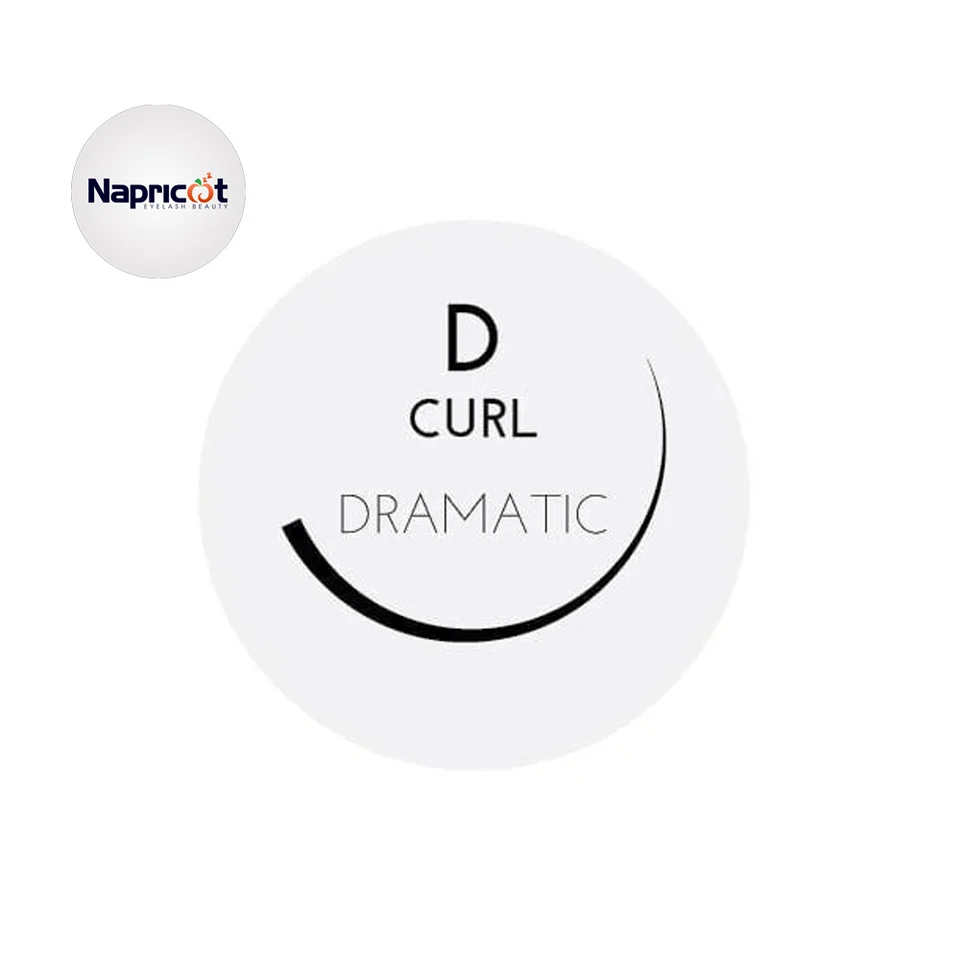
Mrs. Mina has small eyes and natural lashes that grow downwards. She also often wears heavy makeup.
The technician chose D Curl to create a widening and lifting effect. The result is big, sharp eyes, suitable for personal style and special occasions.
However, the technician also advised the customer on the care regimen to maintain the curl for a long time.
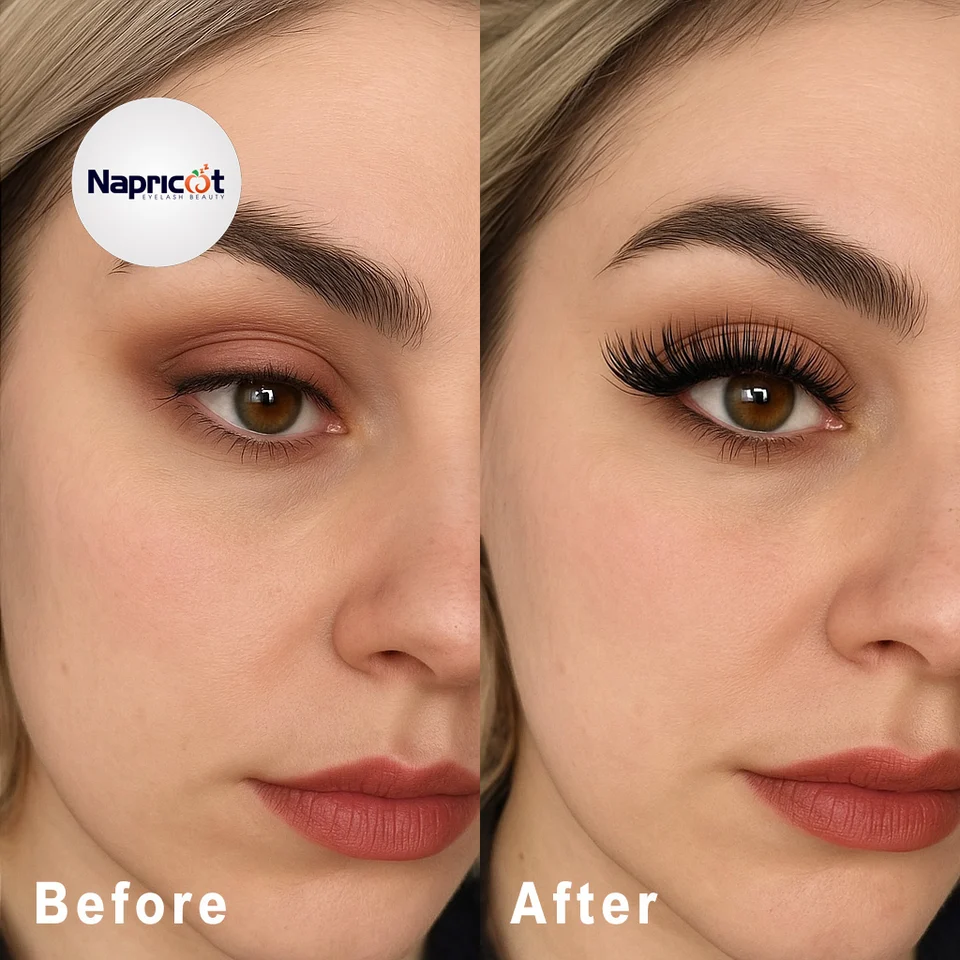
Pros and Cons
Pros
- Dramatic lift and curl: Provides a bold, glamorous appearance ideal for clients wanting a "wow" or doll-eye effect
- Enhances eye visibility: Makes the eyes look larger and more awake, particularly beneficial for clients with eyes that appear less prominent
- Ideal for certain natural lashes: Works especially well for hooded eyes and downward-pointing natural lashes, as the strong curl lifts and opens up the eyes
- Good retention: The steep shape helps grip the natural lashes, leading to solid retention when applied correctly
- Great for volume and sparse lashes: Effectively adds fullness and creates a lush look even for clients with fewer natural lashes
Cons
- High Level of Impact: The dramatic effect may not align with the preferences of those seeking a subtle or natural enhancement.
- Requires advanced skill: The intense curl demands careful application and isolation, often requiring a more experienced technician
- Potential for lash stress: Might put extra pressure on very thin or weak natural lashes, increasing risk of discomfort or damage
- Higher maintenance: The bold curl requires proper aftercare to maintain its shape and prevent early fallout
- Not suitable for all lash types: Can look artificial on clients with very straight or upward-growing natural lashes, and may not blend as naturally as softer curls
Characteristics of D Curl Eyelash Extensions
Technical Specifications
- Steep curl angle: Angle of curl is typically 70-90 degrees or higher, producing a very visible, dramatic upward lift
- Doll-eye effect: Ideal for creating wide, open, and glamorous eyes—a distinct contrast with the more natural look of C Curl
- Thicker or stronger base: The lash extension may have a firmer or slightly thicker base to support the bold curve
Application Versatility
- Multiple techniques: Popular for use in volume, hybrid, and advanced classic sets—particularly for clients requesting a show-stopping look
- Noticeable difference from C Curl: Opens the eye to a much greater extent, creating a more standout and elongated lash line
Suitable Eye Shapes for D Curl Extensions
Ideal Eye Shapes
- Hooded eyes: The steep curl opens up the eye, making lashes more visible over the lid
- Downward-pointing natural lashes: Acts as a corrective curl, lifting lashes upwards for a refreshed appearance
- Deep-set eyes: Brings lashes forward, making deep-set eyes appear more open and awake
- Round eyes: Enhances and elongates, creating a striking, almond-like effect
Comparison of C and D curl lashes
Curvature & Lift Effect & Eye Shape
- C Curl: 60-degree lift, soft and natural
- D Curl: 70-90 degrees lift, bold and dramatic
- Best for: Round/monolid (C), Almond/hooded (D)
- Ideal use: Daily wear (C), Events/photos (D)
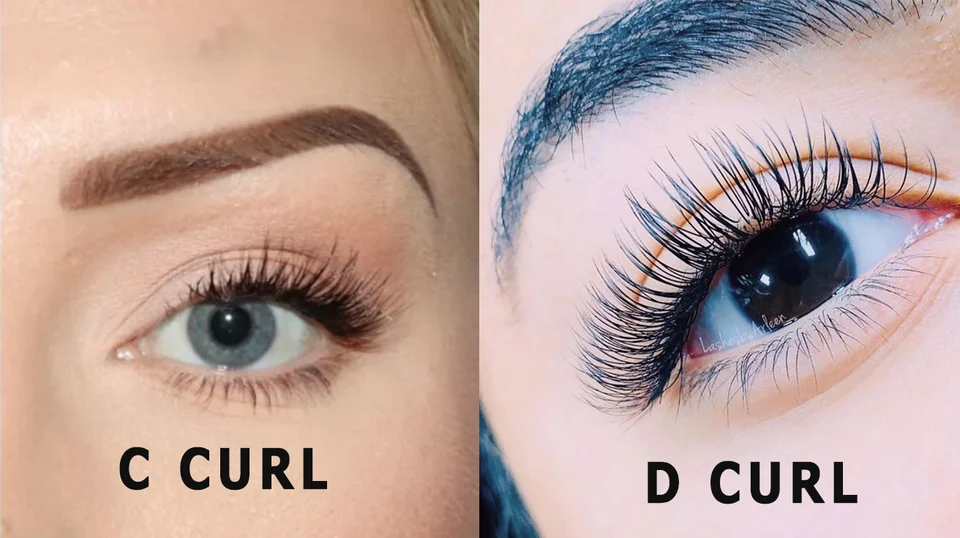
Feature | C Curl | D Curl |
|---|---|---|
Curl Angle | 60 degrees | 70-90 degrees |
Look Achieved | Natural, Everyday | Dramatic, Glamorous |
Eye Shape Match | Round, Downturned, Monolid | Almond, Hooded, Downward Lashes |
Methods Applied | Classic, Volume, Hybrid | Volume, Russian Volume |
Maintenance Level | Low to Medium | Medium to High |
Thickness (Classic) | 0.15–0.20 mm | 0.15–0.20 mm |
Thickness (Volume) | 0.05–0.07 mm | 0.05–0.07 mm |
Best For | Everyday wear | Special events, Glamorous looks |
This comparison table highlights the main differences between c curl vs d curl lashes in terms of curl angle, look achieved, and ideal use cases.
If you want to choose the best curling eyelash for natural connecting lashes then check out this article: Choosing the Best Lash Curl for Natural Eyelash Extensions
Client Preferences
Understanding client preferences is crucial for successful lash extension services. Different curl types attract distinct client profiles based on their lifestyle, profession, and aesthetic preferences.
Suitability and Use Cases for C Curl
- Clients who prefer a natural and subtle enhancement: Clients who prefer subtle enhancement that complements their natural beauty without appearing overdone
- Professional requirements: Students, office workers, and professionals in conservative work environments who need polished yet understated looks
- First-time clients: Newcomers to lash extensions who want to ease into the experience with a more natural appearance
- Daily wear preference: Clients seeking low-maintenance extensions suitable for everyday activities and minimal makeup routines
Suitability and Use Cases for D Curl
- Clients who prefer a bold, statement-making look: Clients who embrace bold, statement-making looks and aren't afraid to stand out
- Event-focused clientele: Those preparing for special occasions, photoshoots, weddings, or formal events requiring glamorous appearance
- Creative professionals: Performers, models, influencers, makeup artists, and entertainment industry professionals who need striking visual impact
- Fashion-forward individuals: Style-conscious clients who view lashes as a key fashion accessory and prefer trendy, eye-catching looks
Importance of Proper Consultation
Effective consultation is essential to match the right curl type with client needs. Technicians must assess not only eye shape and natural lash condition but also lifestyle factors, maintenance preferences, and aesthetic goals to ensure client satisfaction and optimal results.
Ease of Application
The application complexity varies significantly between curl types, directly impacting the skill level required and the quality of results achieved.
C Curl Application Characteristics
- Beginner-friendly technique: Easier to handle and manipulate during application, making it ideal for new technicians or those developing their skills
- Forgiving placement: More tolerance for slight placement variations without compromising the overall aesthetic result
- Simplified isolation: Natural curve allows for easier isolation of individual lashes during the application process
- Predictable behavior: Consistent performance with standard adhesives and application techniques
D Curl Application Challenges
- Advanced skill requirement: The pronounced curve demands precise placement and expert isolation techniques to achieve professional results
- Complex fan creation: Creating uniform volume fans is more challenging due to the steep angle, requiring advanced hand positioning and control
- Close-to-lash-line placement: The dramatic curl can make it difficult to achieve optimal placement close to the lash line without touching the skin
- Higher precision demands: Requires meticulous attention to angle, direction, and spacing to maintain the intended dramatic effect
Which Is Best for You: C or D Curl Lashes?
Selecting between C Curl and D Curl extensions requires careful consideration of multiple factors including desired effect, eye shape compatibility, personal style preferences, and lifestyle requirements. This comprehensive guide will help determine the optimal choice for individual client needs.
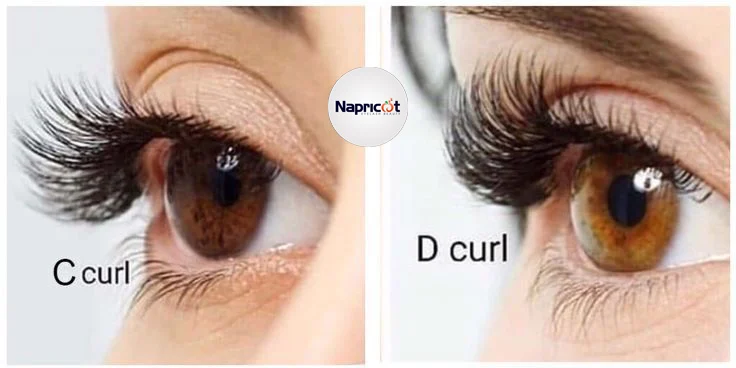
Key Factors to Consider
Aesthetic Goals Assessment
- For a natural enhancement: C Curl provides subtle lift and eye-opening effect while maintaining natural appearance
- For a dramatic transformation: D Curl delivers bold "doll-eye" or "cat-eye" effects for maximum visual impact
- Professional environment compatibility: C Curl offers workplace-appropriate sophistication
- Special occasion requirements: D Curl creates statement looks perfect for events and photography
Eye Shape Compatibility Analysis
- C Curl optimal candidates: Single eyelids, hooded eyes, slightly downward-angled eyes, clients with naturally long lashes
- D Curl ideal candidates: Small eyes, deep-set eyes, hooded lids that conceal lash base, clients seeking corrective enhancement
Lifestyle and Maintenance Considerations
Daily Routine Compatibility
- Low-maintenance preference: C Curl requires minimal styling and blends seamlessly with natural makeup routines
- High-impact lifestyle: D Curl suits clients who embrace bold aesthetics and regular professional makeup application
Professional and Social Context
- Conservative environments: C Curl provides polished enhancement suitable for corporate, academic, and traditional settings
- Creative industries: D Curl complements performance, fashion, entertainment, and artistic professional requirements
Technical Application Factors
Technician Skill Level Requirements
- Beginner to intermediate: C Curl offers forgiving application with consistent results
- Advanced expertise: D Curl demands precision technique and extensive experience for optimal outcomes
Maintenance and Longevity
- Extended wear preference: C Curl typically provides longer retention with standard aftercare
- Intensive maintenance acceptance: D Curl requires dedicated care routine and regular professional touch-ups
Final Recommendation Guidelines
Choose C Curl If:
- Seeking natural, elegant enhancement for daily wear
- Your professional or academic environment requires a polished yet understated appearance.
- New to lash extensions or prefer low-maintenance beauty routines
- Have naturally prominent eyes that need subtle definition
Choose D Curl If:
- Desiring dramatic, attention-grabbing transformation
- Have small, deep-set, or hooded eyes requiring significant lift
- Your profession is in a creative, entertainment, or fashion field, or you frequently attend events where a standout look is desired
- Experienced with lash extensions and enjoy bold beauty statements
Hybrid Approach Consideration
Advanced technicians may recommend combining both curl types within a single set, using C Curl for inner corners and transitioning to D Curl at outer corners, creating customized results that balance natural beauty with strategic dramatic accents.
Professional Consultation Importance
The optimal curl selection ultimately depends on individual eye anatomy, lifestyle factors, and aesthetic preferences. Professional consultation ensures proper assessment of all variables, leading to results that enhance natural beauty while meeting personal and professional requirements.
“D Curl is your best friend when working with downward lashes but for balance and long-term comfort, knowing how to combine curls is what separates pros from beginners.”
— Rockie Ng, Founder of Napricot
The Importance of Professional Consulting
Professional consultation prior to lash extension application is fundamental to achieving optimal results, ensuring client safety, and maximizing satisfaction. A comprehensive consultation process not only determines the most suitable curl type but also establishes realistic expectations and proper care protocols for long-term success.
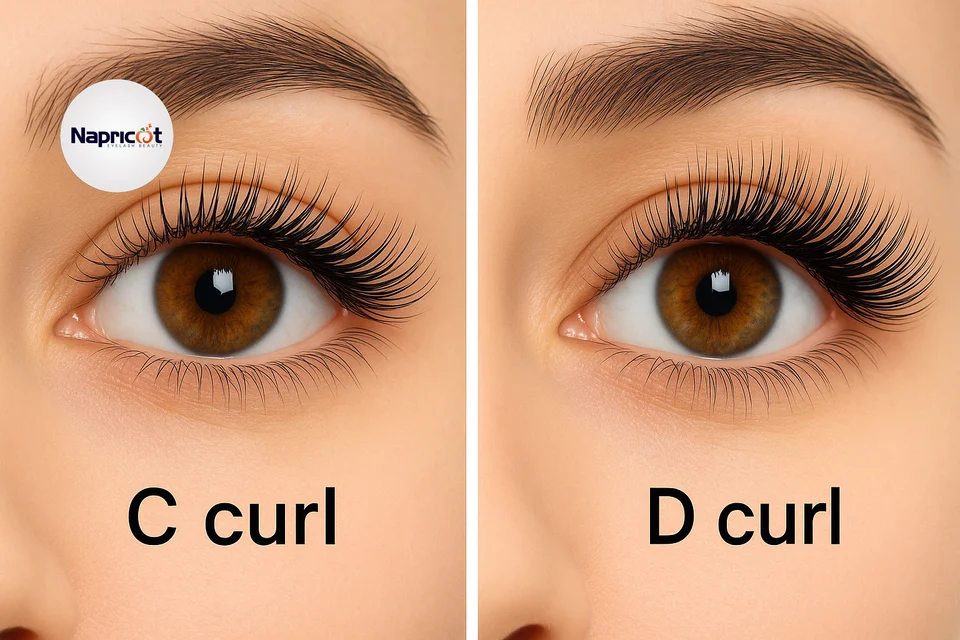
Natural Eyelashes Review
Comprehensive Lash Assessment
- Density evaluation: Assessment of natural lash quantity per millimeter to determine appropriate extension density and weight distribution
- Structural analysis: Examination of lash thickness, length, strength, and natural growth direction to select compatible extension specifications
- Growth cycle assessment: Understanding individual lash cycles to predict retention patterns and maintenance scheduling
Health and Condition Evaluation
- Sensitivity screening: Identification of potential allergic reactions, previous adverse experiences, or underlying sensitivities
- Damage assessment: Detection of existing lash damage, thinning, or breakage that may affect extension suitability
- Medical considerations: Review of conditions such as alopecia, trichotillomania, or medication effects that could impact lash health
Foundation for Technical Decisions
- Weight capacity determination: Ensuring natural lashes can support chosen extension weight without causing stress or premature shedding
- Curl compatibility: Matching extension curl to natural lash angle and strength to prevent lifting or poor retention
- Customization requirements: Identifying need for varied lengths, thicknesses, or curls within a single set
Eye Shape Analysis
Anatomical Assessment
- Lid structure evaluation: Analysis of hooded, deep-set, prominent, or standard lid positioning to optimize extension placement
- Eye shape classification: Identification of almond, round, downturned, upturned, close-set, or wide-set characteristics
- Symmetry considerations: Assessment of natural asymmetries requiring corrective placement techniques
Design Strategy Development
- Enhancement planning: Determining optimal curl patterns, length variations, and volume distribution to complement natural features
- Corrective techniques: Implementing strategic placement to address concerns such as droopy lids, small eyes, or asymmetrical features
- Proportional balance: Ensuring extension design harmonizes with facial structure and enhances overall aesthetic appeal
Technical Application Adjustments
- Angle optimization: Adjusting placement angles to work with natural eye contours and maximize curl visibility
- Mapping strategy: Creating detailed placement plans for inner, middle, and outer eye sections
- Style integration: Coordinating extension design with client's facial features and personal aesthetic preferences
Discuss Your Wishes
Aesthetic Goal Clarification
- Style preference exploration: Understanding client's desired look from natural enhancement to dramatic transformation
- Lifestyle integration: Assessing daily routines, professional requirements, and maintenance capacity
- Occasion-specific needs: Identifying special events, photography requirements, or seasonal preferences
Expectation Management
- Realistic outcome discussion: Explaining achievable results based on natural lash foundation and eye shape limitations
- Timeline explanation: Clarifying application duration, initial settling period, and long-term maintenance schedule
- Maintenance commitment: Discussing required aftercare, refill frequency, and ongoing investment requirements
Collaborative Decision Making
- Option presentation: Providing multiple design alternatives with detailed pros and cons for each approach
- Compromise solutions: Finding optimal balance between client desires and technical feasibility
- Final agreement: Confirming chosen specifications, expected outcomes, and care responsibilities
Engineering and Safety
Material Quality Assurance
- Extension selection: Utilizing premium-grade synthetic or silk lashes with verified safety certifications
- Adhesive specifications: Employing medical-grade, hypoallergenic adhesives appropriate for sensitive eye area application
- Tool sterilization: Implementing comprehensive sanitization protocols for all application instruments
Application Safety Protocols
- Workspace preparation: Maintaining sterile environment with proper lighting, ventilation, and ergonomic setup
- Personal protective measures: Utilizing masks, gloves, and eye protection to prevent cross-contamination
- Gentle technique implementation: Employing precise, non-invasive application methods to protect natural lashes and surrounding skin
Risk Management
- Allergy prevention: Conducting patch tests when indicated and maintaining emergency response protocols
- Complication awareness: Educating clients about potential risks including irritation, infection, or allergic reactions
- Professional accountability: Providing clear contact information for post-application concerns and emergency situations
Care and Maintenance Notes
Proper aftercare directly determines extension longevity, retention quality, and overall eye health. Comprehensive maintenance education is essential for achieving optimal results and preventing complications.
Initial Care Period (First 24-48 Hours)
- Water avoidance: Complete moisture restriction during adhesive curing period to ensure proper bond formation
- Heat and humidity precautions: Avoiding saunas, steam rooms, hot showers, and excessive humidity exposure
- Physical protection: Preventing rubbing, touching, or sleeping face-down to avoid displacement
You want to keep your eyelash extensions curled and this article will guide you through it.
Daily Maintenance Routine
- Gentle cleansing: Using oil-free, lash-safe cleansers to remove debris without compromising adhesive bonds
- Proper drying technique: Pat-drying with lint-free materials and allowing natural air drying
- Brushing protocol: Daily combing with clean spoolie brushes to maintain shape and prevent tangling
Product Restrictions
- Oil-based product avoidance: Eliminating makeup removers, cleansers, and moisturizers containing oils that dissolve adhesive
- Waterproof makeup limitations: Avoiding waterproof mascaras and eyeliners that require aggressive removal
- Chemical exposure prevention: Limiting contact with chlorinated water, harsh cleansers, and acidic products
Professional Maintenance Schedule
- Regular refill appointments: Scheduling touch-ups every 2-3 weeks to maintain fullness and appearance
- Health monitoring: Professional assessment of natural lash condition and extension integrity
- Removal protocols: Safe professional removal when discontinuing extensions to prevent natural lash damage
Warning Signs and Emergency Care
- Immediate attention indicators: Persistent redness, swelling, unusual discharge, or vision changes
- Professional intervention: Contacting technician for guidance on irritation, premature shedding, or discomfort
- Prevention strategies: Following all aftercare instructions and attending scheduled maintenance appointments
Adherence to proper care protocols and regular professional maintenance ensures optimal extension performance, protects natural lash health, and maximizes client investment in lash enhancement services.
Frequently Asked Questions
What is the difference between a C curl and a D curl in eyelash extensions?
C curl lashes have a moderate, natural-looking curl (about 60°) that gently lifts the lashes, ideal for everyday wear and subtle eye enhancement. D curl lashes feature a more dramatic, pronounced curl (70°–90°+) creating a bold, "doll-eye" effect perfect for a striking, glamorous look.
Can I mix C curl and D curl lash extensions?
Yes, mixing C curl and D curl lashes is common to create a hybrid look. Typically, C curl is applied on the inner and middle lashes for a natural lift, while D curl is used on the outer lashes to add dramatic flare and lengthening effect.
C curl vs d curl for hooded eyes?
D curl is generally better for hooded eyes because its strong curl lifts and opens the eye area more effectively. C curl may work if the hooding is mild, but stronger curls like D or L curl are usually recommended.
C curl or D curl for almond eyes?
Both curls suit almond-shaped eyes well. C curl offers a soft, natural enhancement while D curl delivers a more noticeable, glamorous effect. The choice depends on personal style and desired impact.
How can I create a hybrid look using C curl and D curl lashes?
Apply C curl lashes on the inner to mid-sections of the eyelash line for natural-looking lift and blend, then apply D curl lashes on the outer corners to create a dramatic, eye-opening effect. This combination balances natural beauty with boldness.
Conclusion
Choosing between C Curl vs D Curl eyelash extensions fundamentally depends on your natural lash characteristics, eye shape, and desired look.
The best choice is guided by professional consultation, taking into account personal preferences and anatomical features.
Many lash stylists recommend mixing both curls to create bespoke hybrid looks, balancing natural beauty and intensity.
Understanding these nuances ensures you select extensions that not only beautify your eyes but also maintain lash health and longevity because the perfect curl is the one that fits you best.
About Author
**Rockie Ng** is a certified lash artist and the founder of **Napricot**, a brand specializing in high-quality premade lash fans. With over 6 years of hands-on experience in the lash extension industry, she has worked with thousands of lash artists worldwide to improve application techniques, retention, and styling outcomes.
Rockie is passionate about bridging the gap between product quality and lash education. Through Napricot, she actively shares insights on lash trends, technical guidance, and product innovations to help lash professionals deliver better results faster and safer.